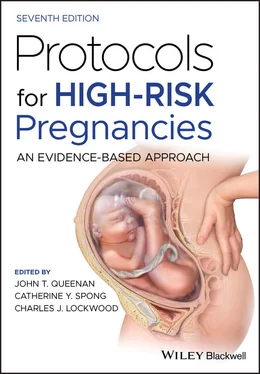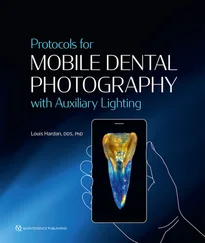This includes women with serologically confirmed FNAIT resulting in fetal and/or neonatal thrombocytopenia alone in prior pregnancies, without ICH. These patients should be empirically started at 20 weeks’ gestational age with either IVIG 1 g/kg/week and prednisone 0.5 mg/kg/day or IVIG 2 g/kg/week. Beginning at 32 weeks’ gestational age, therapy should be intensified to IVIG 2 g/kg/week with prednisone 0.5 mg/kg/day, and this regimen is continued through delivery.
This includes women with serologically confirmed FNAIT and a prior fetus or newborn with ICH occurring after 28 weeks’ gestational age. For these patients, empirical therapy involves IVIG 1 g/kg/week beginning at 12 weeks. At 20 weeks, the regimen should be intensified by either adding prednisone 0.5 mg/kg/day or increasing monotherapy IVIG to 2 g/kg/week. At 28 weeks, therapy should be increased to IVIG 2 g/kg/week with prednisone 0.5 mg/kg/day, and this regimen is continued through delivery.
Stratum 4 (extremely high risk)
This includes women with serologically confirmed FNAIT and a prior fetus or newborn with ICH occurring prior to 28 weeks’ gestational age. For these patients, empirical therapy involves IVIG 2 g/kg/week beginning at 12 weeks. At 20 weeks, prednisone 1 mg/kg/day is added to the IVIG, and this regimen is continued through delivery.
Delivery of a pregnancy complicated by FNAIT is generally recommended at 37–38 weeks’ gestational age by cesarean for cases in the medium‐risk category and 35–36 weeks by cesarean for cases in the high‐risk or extremely high‐risk categories. Late preterm antenatal corticosteroids should be considered for deliveries planned before 37 weeks’ gestational age. There is no role for amniocentesis for fetal lung maturity as a part of medical decision making in these cases.
Cesarean delivery is recommended as mode of delivery for pregnancies complicated by FNAIT. For patients who are highly motivated despite this advice to undergo a trial of labor, fetal blood sampling by cordocentesis may be considered shortly prior to planned delivery. Patients should be informed of the possible risk of serious complications with cordocentesis in this setting, and that complications may include emergency cesarean delivery or perinatal loss should severe fetal thrombocytopenia exist. Platelets should be available at the time of cordocentesis should severe thrombocytopenia (under 50 000/mL 3) be identified. With demonstration of a platelet count over 80 000/mL 3, labor induction is reasonable. Beneath this threshold, cesarean delivery is strongly recommended, even if the fetus has received platelets. Operative vaginal delivery is discouraged in pregnancies complicated by FNAIT.
When possible, delivery of a fetus at risk for severe thrombocytopenia due to FNAIT should ideally be coordinated with experienced neonatology and pediatric hematology subspecialists. Newborn evaluation should involve a thorough newborn physical and neurological examination, platelet count determination, and head ultrasound if the birth platelet count is under 100 000/mL 3or any neurological abnormalities are detected. Untreated, FNAIT‐associated thrombocytopenia typically resolves within the first two weeks of life. Rarely, thrombocytopenia can persist for months after delivery, and require prolonged care.
For newborns with severe thrombocytopenia (under 30 000/mL 3) or clinical signs of bleeding, controversy exists as to the optimal source for platelet transfusion. The mother can serve as a platelet donor so long as she donates platelets a few days prior to planned delivery intervention. This allows for “washing” to remove disease‐causing antibodies. Alternatively, use of donor platelets negative for the offending HPA antigen is a commonly recommended practice. Finally, limited evidence supports the safety and efficacy of using donor platelets unmatched for the offending HPA antigen, especially in situations in which matched platelets are unavailable. This approach might even theoretically shorten the postnatal disease course by hastening the neonatal clearance of maternal alloantibodies. Decisions regarding platelet sources for potential fetal and neonatal transfusions should ideally involve input from obstetrics and pediatric care providers.
The most important predictor of long‐term neurological outcomes is whether an ICH occurred. Children who are successfully treated with noninvasive therapy appear to have normal neurological development.
Fetal and neonatal alloimmune thrombocytopenia is a maternal alloimmune condition in which specific maternal antibodies target paternally derived HPA expressed on fetal platelets, resulting in potentially severe fetal and neonatal thrombocytopenia. The diagnosis of FNAIT is first suspected based upon a qualifying history of a fetus or neonate with suspected or confirmed thrombocytopenia. A suspected FNAIT diagnosis requires evaluation by parental blood testing, which includes HPA genotyping of both parents. Should a platelet antigen incompatibility be determined within a tested couple, further maternal testing for the presence of antigen‐specific anti‐HPA antibodies is performed to secure a FNAIT diagnosis. Given that disease worsens with successive pregnancies and given that FNAIT‐associated ICH usually occurs prior to labor, antenatal therapy is strongly recommended in all pregnancies complicated by FNAIT to reduce risk for severe thrombocytopenia and related ICH.
A risk‐based noninvasive approach has been developed that we recommend as a management algorithm. This strategy stratifies patients into risk‐based strata based upon clinical history, tailoring treatment regimen intensity based upon past disease severity. Delivery of a pregnancy complicated by FNAIT is generally recommended at 37–38 weeks’ gestational age by cesarean for cases in the medium‐risk category and 35–36 weeks by cesarean for cases in the high‐risk or extremely high‐risk categories. When possible, delivery of a fetus at risk for severe thrombocytopenia due to FNAIT should ideally be coordinated with experienced neonatology and pediatric hematology subspecialists.
1 Berkowitz RL, Lesser ML, McFarland JG, et al. Antepartum treatment without early cordocentesis for standard‐risk alloimmune thrombocytopenia. Obstet Gynecol 2007; 110:249–55.
2 Bussel JB, Berkowitz RL, Hung C, et al. Intracranial hemorrage in alloimmune thrombocytopenia: stratified management to prevent recurrence in the subsequent affected fetus. Am J Obstet Gynecol 2010; 203(2):135.e1.
3 Kiefel V Bassler D, Kroll H, et al. Antigen‐positive platelet transfusion in neonatal alloimmune thrombocytopenia (NAIT). Blood 2006; 107(9):3761–3.
4 Lieberman L, Greinacher A, Murphy MF, et al. Fetal and neonatal alloimmune thrombocytopenia: recommednations for evidence‐based practice, an international approach. Br J Hematol 2019; 185(3):549–62.
5 Pacheco LD, Berkowitz RL, Moise KJ, et al. Fetal and neonatal alloimmune thrombocytopenia: a management algorithm based on risk stratifaction. Obstet Gynecol 2011; 118:1157–632.
6 Peterson AP, McFarland JG, Curtis BR, et al. Neonatal alloimmune thrombocytopenia: pathogenesis, diagnosis, and management. Br J Haematol 2013; 161(1):3–14.
7 Provan D, Stasi R, Newland AC, et al. International consensus report on the investigation and management of primary immune thrombocytopenia. Blood 2010; 115(2):168.
8 Winkelhorst D, Murphy MF, Greinacher A, et al. Antenatal management in fetal and neonatal alloimmune thrombocytopenia: a systematic review. Blood 2017; 129:1538–47.
Читать дальше












